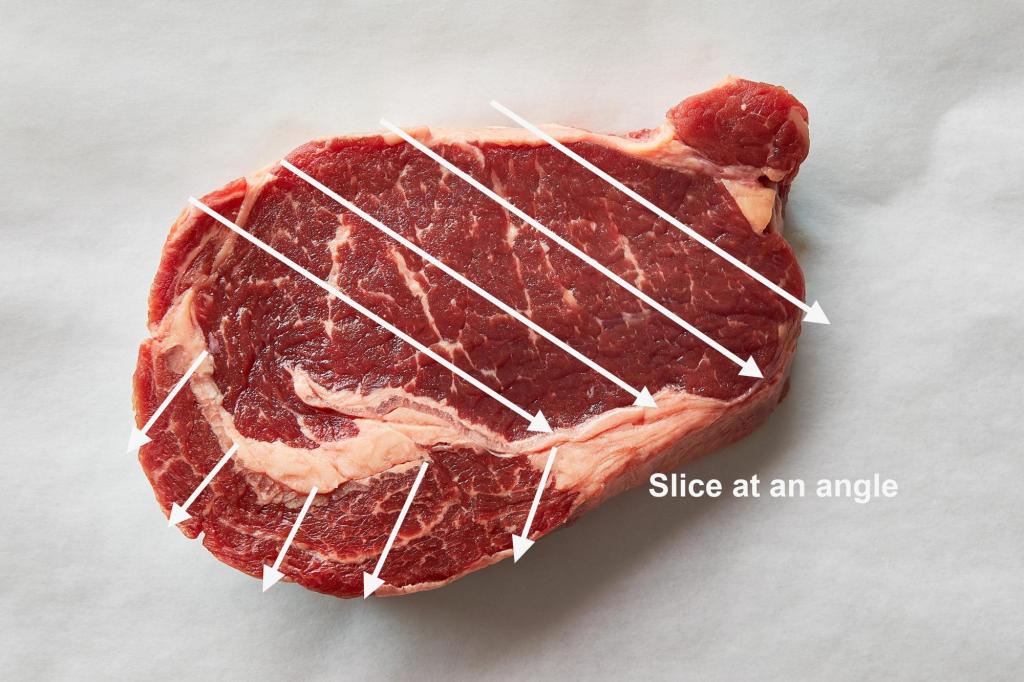By Eric Kim, The New York Times
Do you know what a “grain” is? Not a grain of sand, cereal or truth, but the grain of a piece of wood, fabric or meat — all references to the direction of the fibers running along an object like a table, sweater or steak.
“Slice against the grain,” you may have read in a recipe. It’s arguably the most important step in enjoying steak, yet one that isn’t always intuitive.
To cut against the grain means to run a sharp knife at an angle to the muscle fibers running through a piece of meat. The idea here is to shorten those fibers as much as possible so chewing them is a breeze. “Otherwise, you’re going to wreck your teeth,” said Steve Kapusta, a butcher at Patton’s Meat Market in Duluth, Georgia.
According to Kapusta, you can cook a steak perfectly, juicy as can be, but if you don’t carve it against or across the grain to shorten those muscle fibers, then it won’t be as tender.
Eating meat that’s been sliced along the grain is, according to my friend, cookbook author Rick Martínez who also develops recipes for New York Times Cooking, the equivalent of chewing on “a ball of yarn” from which you’ve “sucked out the juice.” Unless you’re making a braised shredded-meat dish like ropa vieja, the long strands of tougher cuts will take a while to break down.
How do I find the grain?
Sometimes it can be hard to locate the direction of the grain after a steak has browned and darkened in color, so Kapusta suggests identifying it before cooking. When steaks are raw and bright red, the muscle fibers are sometimes easier to see. Again, look for parallel lines to cut across them later.
Finding the grain couldn’t be easier on a skirt, hanger or flank steak, where the muscle fibers are highly visible. That’s because these particular cuts come from parts of the animal that really move, making them especially flavorful. Lucky for us, all it takes is shortening those long fibers — by slicing against them at an angle — to create long, tender strips.
Why can’t I find the grain?
Not all steaks have an easily identifiable grain. If you can’t see obvious parallel lines on the surface, it’s most likely because that piece of meat has a very fine grain from muscles that aren’t used much. Also, some steaks have already been purposefully cut across the grain from a larger portion, such as the rib, tenderloin or short loin.
In filet mignon and New York strip (both of which, together, make up a T-bone or porterhouse steak), the grain usually runs vertically, from top to bottom. Same with the well-marbled and especially fatty rib-eye, which are steaks sliced from the rib portion of the cow.
The meat on all of these steaks will be tender no matter how you slice them. But here’s a trick for overachievers: If your rib-eye, filet or strip is thick enough, or rather tall enough, then slicing it at an angle from top to bottom is one way to shorten those vertical fibers even further, resulting in even more tender meat. Some would say this is overthinking it; for others, it’s the little things in life that count.
If your steak is already cooked and you’re having trouble finding the grain, then just make one initial cut at the end and adjust any subsequent cuts if needed.
What if there are grains running in different directions?
If the grain changes midway, just alter the direction of your cut. This can happen in any steak, but it is especially noticeable in the tri-tip (from the bottom sirloin), where the grain can be going one direction at one end of the steak and another direction toward the other end.
In a rib-eye steak, the direction of the grain shifts slightly between the steak’s eye (the large center portion), its deckle or cap (the long outer edge that fences the eye in) and its tail (the tender little nugget in the corner). Just pivot as you carve, and pay attention to the look of your sliced pieces.
Did I do it right?
One sign that a steak has been properly cut against the grain is to check the surface area of the sliced piece: If you see a vaguely diamond pattern across the plane of juicy meat, then you’re in for a treat — it has been cut against the grain and is likely to be tender. But if you see parallel lines, it’s been cut along the grain and might take a few more chews to break down the fibers enough to swallow.
That’s OK! Just turn your knife about 90 degrees and slice perpendicular to those lines.
It’s not just cooks who need to know this; diners should know, too. When a whole steak arrives at your table, are you cutting it in the direction that will make it the most pleasurable eating experience? This might seem granular, but are you, fork and knife in either hand, cutting it against the grain?
This article originally appeared in The New York Times.
Originally Published:
